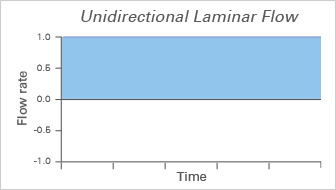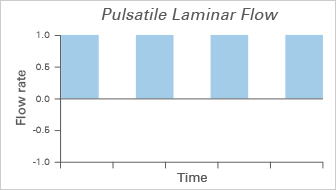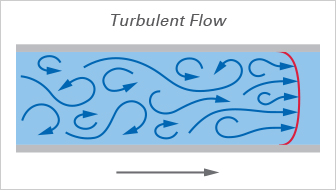The Different Types of Flow
Several types of flow with defined characteristics occur in different tissues and settings. Basically, flow types can be subdivided into laminar flow and turbulent flow:
Type of flow | Physiological occurrence | Flow rate | Flow | Generation with | |
 |
|
| |||
 |
|
|
|
| |
 |
|
|
|
| |
 |
|
|
|
| |
 |
|
|
|
|
Laminar flow is defined as the movement of liquids without turbulences. The fluid flows in parallel layers with no disruption between them. Laminar flow can be subdivided into the following:

Laminar flow profile. Arrows represent the distribution of velocities.
Unidirectional laminar flow is encountered in most small healthy biological vessels, such as small arteries and veins. In vivo, certain cells, such as endothelial cells and kidney epithelial cells, are constantly exposed to flow.
Experimentally, unidirectional laminar flow is achieved by perfusing medium through low-walled channels, and by keeping both the flow direction and velocity constant over time.
ibidi Solutions
- The ibidi Pump System is ideally suited for creating a unidirectional laminar flow.
- The µ-Slide I Luer Family and the µ-Slide VI 0.4 Channel Slides are recommended for homogeneous unidirectional laminar flow experiments. Using these slides, homogeneous laminar shear stress covers the whole channel area, except for a thin band on either side of the channel walls and near the reservoirs. The width of these bands is proportional to the channel's height.

Non-Uniform Laminar Flow
Unidirectional laminar flow can also occur in a non-uniform pattern. In this case, the flow direction is constant whereas the flow rate spatially varies across the cell layer. In vivo, a non-uniform laminar flow occurs at vessel branching sites.
Experimentally, non-uniform laminar shear stress can be achieved by a special channel geometry, which generates flow rate variations at specific sites within a slide. Using this experimental setup, different shear stresses on cells can be investigated using a single sample. This is an efficient way to investigate the effect of different shear stresses on cell physiology.
ibidi Solutions
The µ-Slide y-shaped has been designed for studies of non-uniform flow using the ibidi Pump System. Under flow conditions, the shear stress level depends on the region on the slide: in the branched region, the prevalent shear stress is approximately half of that in the single straight channel regions. Please refer to Application Note 18 for numerical simulations of exact shear stress values at the branching points.
Please note: It is experimentally impossible to study turbulences in a µ-Slide y-shaped.
Pulsatile laminar flow is encountered in large arterial vessels due to the fluctuations caused by the heartbeat. Experimentally, this type of flow can be mimicked by employing a flow with a periodically changing flow rate while keeping the flow direction constant.
ibidi Solutions
- The ibidi Pump System is ideally suited for creating a pulsatile laminar flow. Please find detailed information in the Instruction Manual for the ibidi Pump System.
- The µ-Slide I Luer Family and the µ-Slide VI 0.4 Channel Slides can be used for pulsatile laminar flow experiments.

Oscillatory laminar flow is accepted as a means of simulating turbulences when using flow chambers. Although the flow is laminar, there is no main direction because the flow direction is changed at regular intervals (e.g., every 0.5 seconds). Besides during valve switching, the flow rate is kept constant.
A. Sabine, et al. FOXC2 and fluid shear stress stabilize postnatal lymphatic vasculature, The Journal of Clinical Investigation, 2015, 10.1172/JCI80454
read abstract
ibidi Solutions
- The ibidi Pump System is ideally suited for creating oscillatory flow conditions. Please find detailed information in the Instruction Manual for the ibidi Pump System.
- The µ-Slide I Luer Family and the µ-Slide VI 0.4 Channel Slides can be used for oscillatory laminar flow experiments.

Turbulent flow is characterized by unpredictable changes in both flow rate and direction over time. In vivo, turbulences are rare and can only be found during pathophysiological processes.
T. Hosoya, et al. Differential Responses of the Nrf2-Keap1 System to Laminar and Oscillatory Shear Stresses in Endothelial Cells. J Biol Chem, 2005, 10.1074/jbc.M502551200
read abstract
ibidi Solutions
Due to physical reasons, turbulent flow cannot be achieved in ibidi flow chambers using physiological flow regimes. Oscillatory laminar flow, which is accepted as a means of simulating turbulences when using flow chambers, can be created using the ibidi Pump System. Please find detailed information in the Instruction Manual for the ibidi Pump System.

Turbulent flow profile. Arrows represent the distribution of velocities.
Read on and learn more about different Applications of Flow Assays.




